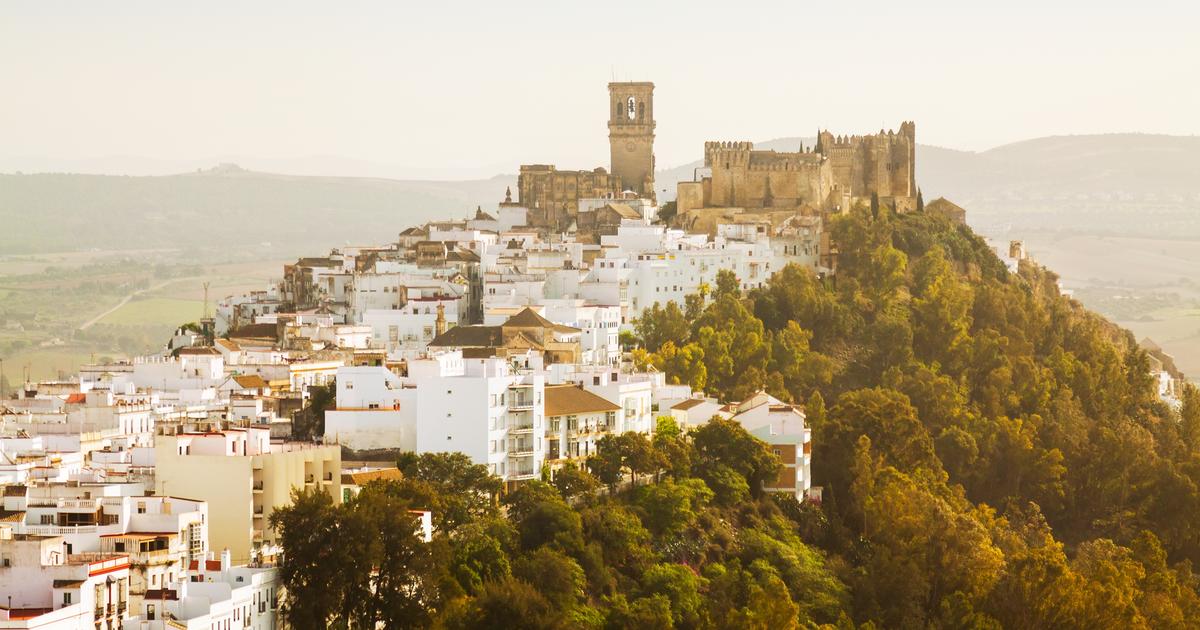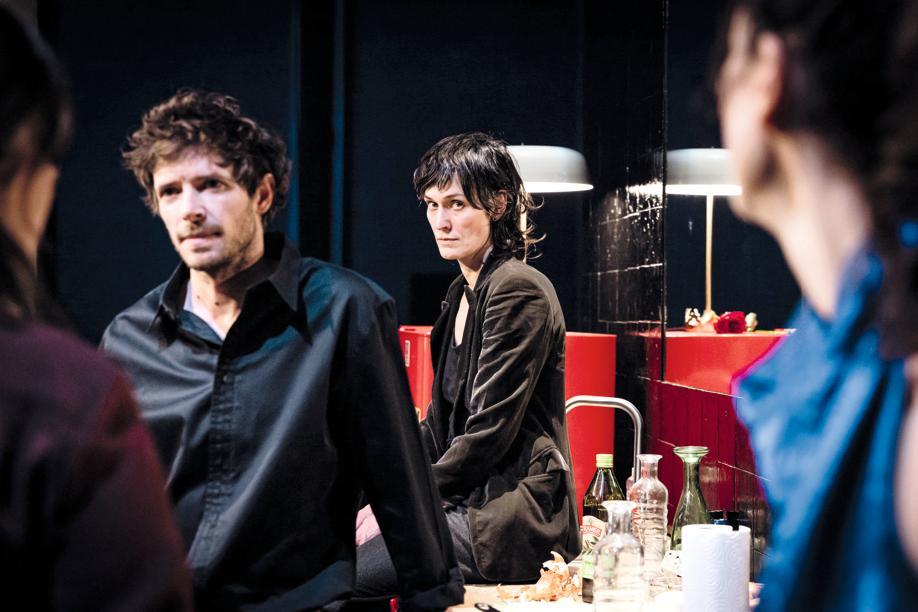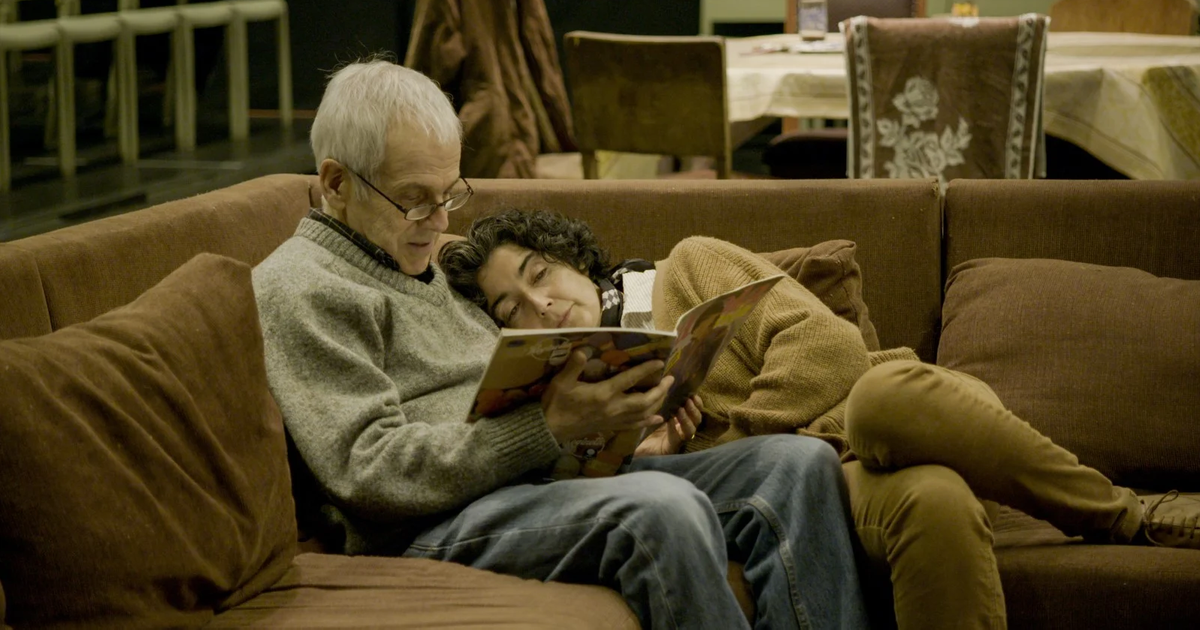Playa Serena, south of Mar del Plata, two and a half kilometers from the lighthouse of Punta Mogotes. It's a summer night from the '50s. On the top floor of the Parador Ariston, a four-leaf clover-shaped construction with a glass façade, people dance to the music of Paul Anka. What abounds is glamour and festive atmosphere, as if the scene were in a boite of the European Saint Tropez or Monte Carlo. Wearing white apron and silver buttons, the waiters serve drinks at the tables next to the windows: from there you can see the moon reflecting on the sea. Romantic wherever you look at it, the most anticipated moment comes with the classic of the Canadian singer, Rest your head on my shoulder.
Over the years, the Ariston, a unique piece of architecture, an emblem of the modern movement, changed its category several times: it went from being a restaurant and boite to a disco, and from a disco to a cantobar, and from cantobar to grill, and from grill to... Thus, every time the original plan was altered for the different spare parts, it deteriorated. And since 1993, when it closed definitively, or at least until now, it was in a state of abandonment. Or worse: after having suffered a series of vandalizations, including two fires, it seems that a bomb has been planted.
Fortunately, and although at this point it already seems unfeasible, a group of neighbors proposed to return it to its original physiognomy and its brightness. Andrea Germinario, 33, is one of the most involved in the cause. Why does he do it? What is your emotional bond with the Parador? What leads you to devote much of your efforts to the restoration of a monument that for others is nothing more than a sad combination of peeling walls and stale wood?
"As there are people who are fans of a rock band, I am a fan of architecture," says Andrea, who received a degree in Art, "at a distance", at the National University of the Littoral. And he adds enthusiastically: "The Ariston is the only construction of the Bauhaus school in Latin America. Yes, a gem, definitely. That is why we insist that the State buy the land and the property and initiate a restoration process accordingly. And then it becomes a museum or cultural center open to the community."
The Ariston, boarded up.
Andrea, who lives with her two cats, Negro and Chiquita, works at the Museum of Contemporary Art of Mar del Plata, the MAR. There he coordinates the production of exhibitions. With a full schedule, he also teaches Art History at a tertiary institute where he studies elocution. And, in addition, she is a yoga teacher. His free time is dedicated to his wakefulness: that the Parador Ariston returns to look like in its best years. As part of this crusade, and always ad honorem, he meets with neighbors, institutions, municipal officials... In short, it is closely monitoring the state of affairs. "And I spread the issue," he says.
-At what point did you start to get involved with this project?
-In 2015 I was studying Cultural Management at the National University of Mar del Plata. And for practical work we were asked to analyze a "singular architecture". Then, as the Ariston had always caught my attention, since I was going to walk in that area with my family, I wrote about this parador, I uploaded it to the Internet on an academic platform and it had an impressive impact. I started calling researchers from all over the world... There I understood the importance of the place.
For his practical work, which he wrote together with Paula Scavuzzo and was entitled Analysis and reflections on a singular architecture, Andrea managed to enter the parador "illegally". One cold and rainy afternoon in August, she went to take pictures with a friend, an admirer of architecture like her, and to reconstruct some of what was lived in those square meters. "When we were near one of the entrances, two boys appeared and told us: 'if you want, we will teach you how to enter'. And they taught us...", says Germinario, willing to take the risk in order to fulfill her wishes, proud of her adventure.
-What did you find in the hostel?
-It was amazing to see the original structure, walk around, imagine how it had worked in its years of splendor. But there was nothing but graffiti and masonry remains.
The parador was inaugurated in 1948.
The origin
In 1947, during the first Peronist government and with the sanction of the horizontal property law, the subdivision of the Playa Serena area began, which included the Alfar, San Jacinto, San Patricio, San Carlos, Costa Azul and Acantilados neighborhoods. Precisely, to promote the sale of land in this sector, the Faculty of Architecture of the UBA commissioned the construction of the parador meters from Route 11.
The design was assumed by the Hungarian architect Marcel Breuer, who had traveled to Argentina to give a seminar at the Faculty of Architecture and ended up thinking the parador together with the Argentines Carlos Coire, then dean of the same Faculty, and his partner, Eduardo Catalano, who years later would build the Casa Catalano in Raleigh. North Carolina, United States, and would donate to Buenos Aires the metallic flower Floralis Generica.
"With Breuer and Catalano we had lunch every day in a restaurant of Carlos Pellegrini at 600," Coire said. "We had received with Catalano the commission of a work, while we ate we could not avoid talking about it, and Breuer was left out of the conversation. At that we looked at Catalano and realized that we thought the same thing: 'What if we invited Breuer to work with us on the play?'"
Coire and Catalano summoned Breuer and the Hungarian accepted without hesitation. "We explained what the theme was: a parador for a beach in Mar del Plata, destined to confectionery for the afternoon and boite with dance floor for the night, and that should be working in four months," continued Coire. "Breuer stared at a fixed point, unfolded a napkin on the table and drew the Ariston clover with this clarification: 'A large perimeter is needed to favor the views of the sea during the day, and at the same time achieve that, at night, the eyes are directed to the dance floor'. That day the restaurant lost a napkin."
At that time, with the consolidated paid holidays, Mar del Plata began to become a popular destination, with workers who enjoyed with their families the first excursions to the beach and its attractions: the rambla, the port, the sea lions ... In addition, Route 2 had just been paved, a road that reached Miramar, and in the middle of that journey the Chapadmalal hotel complex began to be built.
The famous Wassily armchair, another of Breuer's designs.
Highly regarded, Breuer was a master of the German Bauhaus school, which revolutionized art, design and architecture with its innovative ideas. Then, always at the forefront in forms and materials, the Hungarian concretized a production that includes the Unesco building in Paris and the Whitney Museum of American Art in New York, two jewels of modern architecture.
"Breuer was in contact with the most influential architects and designers of his time, and he himself was one of them," Germinario continues with admiration, as if speaking of someone who marked his life. "That is why he designed for the Ariston a building that respected a good part of the postulates of Le Corbusier, the famous Swiss architect: the first floor was supported on columns with the aim of freeing the ground floor and, in addition, the place had large enclosures and horizontal windows".
Andrea Germinario, Bachelor of Art.
The ground floor of the parador included the entrance hall, the cloakroom, the bathroom area and service rooms. On the first floor were located the lounge, bar and premium dance floor, clad with stainless metal sheets on wooden planks.
The construction was done very quickly: in two months. "The Ariston is an intimate place of social gathering, dance, tea and cocktails, away from the urban center of Mar del Plata", defined the magazine Nuestra Arquitectura in April 1948, two months after the inauguration, which had been on February 11 of that year.
"The parador was what is now known as a club house, something that has developed mostly in private neighborhoods," says Germinario. "It served as a gateway, as the main attraction of a neighborhood that invited you to walk around the area or, directly, to buy a piece of land and build a house."
-Were there people who went to the Ariston after passing through the Casino, in the center of the city?
-Yes, right. Especially if I had a car... That is also why the parador was such a revolutionary space: today it is common to go to the beach at night in a bowling plan. But at that time, no. And the Ariston, located 100 meters from the sea, allowed it.
The parador began to decline in the '70s, when it changed ownership several times and the original spirit was altered: there worked the café bar Bruma y Arena, the Maryana nightclub and the Perico grill. It ceased operation in 1993. Abandoned, it was only visited by curious and architecture lovers. As it was born in 1990, Germinario did not get to see the parador in activity.
-Would you have liked to go dancing at the Ariston?
-Of course.
The House on the stream.
Other jewelry
Andrea is also a fan of the House on the Stream, another of the emblematic buildings of Mar del Plata, located in Quintana 3998, corner Funes, about 15 blocks from the José María Minella stadium. Andrea lived with her parents, Vicente and Patricia, and her sister Carolina (four years younger than her) a few meters from that building. "My parents worked in a nursery and passed on to me a love for plants. That's why, when I was little, I always played near the house, in the stream, among the trees...", she recalls. "And in adolescence, when I went to the National School, I spent the day drawing the house and I even made a documentary about that jewel of Marplatense architecture. I'm so scarred by that house that I tattooed it on the inside of one of my wrists."
-Where does the fascination come from?
-Without a doubt, that house defined my identity: my passion for art, architecture, history and nature. If I am what I am, it is largely thanks to that house. And it is what also leads me to fight for the recovery of the Ariston.
Germinario, with his tattoo of the House on the Stream.
In April of this year, and after decades of neglect, the first stage of the recovery of the house, also known as "Casa del Puente", was concluded. The next step is to turn it into a museum and that it can be visited by the public. "Thanks to the efforts of many people, progress was made in the restoration. Now we need to do infrastructure works, such as the bathrooms that are needed to receive visitors, and hire the right staff, "says Andrea.
The history of the House on the Stream dates back to 1942, when the composer and pianist Alberto Williams bought a very particular land, crossed by the stream of Las Chacras, foundational of Mar del Plata. Williams decided to move out of his summer home in the Los Troncos neighborhood because "urban noises" interfered with his work. So, he asked his son, the architect Amancio Williams, and his daughter-in-law, Delfina Gálvez, also an architect, for the project of a house never seen before.
From 1946, the house functioned as a home and music studio, where Alberto Williams composed and rehearsed. Then, in 1970, it was bought by businessman Héctor Lago Beitía, who installed the LU9 Mar del Plata radio station and turned the house into a radio studio, whose slogan was "from the Casa del Puente, a bridge to your house". In 1977, the radio station was shut down by the military government and, gradually, the building decayed into a ruin. In 1997 it was declared a National Historic Landmark. In the end, in 2020 the national State provided the resources to carry out the restoration: 72 million pesos were invested.
El Terraza Palace, in Playa Grande.
The third emblematic construction of the modern movement in Mar del Plata is the Terraza Palace, also known as La Máquina de Type, a building located at Boulevard Marítimo Patricio Peralta Ramos 5659, in Playa Grande. Designed by the Spanish Antonin Bonet, it was inaugurated in 1957. And today, a few meters from the Costa Galana hotel, it is one of the most coveted constructions by residents or tourists who choose to rest in Mar del Plata.
"Bonet was a genius. He thought more about the harmony of forms in space, than about the benefits of financial speculation. The Terraza Palace was built in a staggered way so that the shadow of the construction did not take away sun from the beach, and in that way generate greater harmony with the environment, "describes Germinario.
-What other designs do you admire?
-I love everything that is pure in itself, such as the Salamone route, in the Province of Buenos Aires. You can't believe that someone designed something like that (he refers to the Italian-Argentine architect Francisco Salamone, who built a series of modernist and art deco buildings in towns such as Alberti, Carhué and Saldungaray).
-¿Y fuera de la Argentina?
-El Monte Saint Michel, en el noroeste de Francia, me volvió loca. Fui especialmente a conocerlo.
El parador, por dentro: sólo restos de mampostería.
Cruzada
Andrea no está sola en la búsqueda de recuperar el Parador Ariston. Las entidades barriales del sur de Mar del Plata, el movimiento de murgas, el club social y deportivo Defensores del Sur y el grupo de scouts Islas Malvinas, entre otras agrupaciones, organizaron varias marchas con la consigna “salvemos el parador”.
De parte del municipio marplatense, cuyo intendente es Guillermo Montenegro, de Juntos por el Cambio, “la funcionaria que encabeza la pelea para que el parador sea recuperado, como la Casa sobre el Arroyo, es Magalí Marazzo”, cuenta Germinario.
Otro de los que trabajan en este sentido es Gustavo Nielsen, arquitecto y escritor, ganador del premio Clarín de novela en 2010 con su texto La otra playa. “Si no salvamos el parador, ¿qué vamos a hacer? ¿Dejarlo como está hasta que se caiga solo? ¿Demolerlo? El parador es pequeño, casi una alhaja. Hay que enviar a un joyero a repararla, y hay que visibilizar lo máximo posible todo el proceso”, dice convencido.
Su pasión por el parador lo llevó a escribir un cuento, El fin del paraíso. El comienzo es así: "'El paraíso llega cuando ya no lo necesitamos'. Mi abuelo decía esta frase enigmática. Siempre queremos que el paraíso llegue; sentí que estaba cerca cuando empecé a trabajar en el Ariston. O en lo que quedaba de él. Soy arquitecta, hago patología muraria y recuperación edilicia. Me llamo Silvia. Mi abuelo Vicente, este que ven en la foto, fue metre del Parador, desde agosto de 1949 hasta julio de 1952. Es el que posa feliz delante de los mozos que sostienen bandejas. Lo sé porque me lo contó mi abuela Sara. Tenían una carta de doce platos. Una sopa de tomate con camarones que era una delicia, según ella, picantita y espesa. Rabo de res y tortilla flambeada de postre. Ya no se come rabo en ningún lugar de Mar del Plata'".
There are also foreigners in love with the Ariston, such as the English Vanessa Bell, who has lived in Plaza Congreso for 12 years and runs her site Cremedelacreme, in which she publishes different attractions of national design. "I love Mar del Plata, but it has a potential that is not exploited. I do not understand why Argentines do not understand that by restoring a historic building like the Ariston the area would attract tourists from all over the country and the world. The city should focus on its modernist legacy and take advantage of architectural tourism," Bell says.
The Lost Decades
The collapse of the Parador Ariston and the House on the Stream was not overnight: it began in the 70s, and occurred in parallel with the national crisis. With the fall of the economy but also with cultural losses. Can these jewels of architecture be thought of as a metaphor for Argentina's decadence, for a greatness in ruins today?
"Yes, it's terrible but it's like this. The deterioration of these monuments had to do with the economic crisis, of course. But it is also the result of the lack of a comprehensive project, a plan that goes beyond governments and political parties. If there is an economic crisis, some projects may be suspended, but never canceled," says Hugo Kliczkowski, an Argentine architect living in Madrid, Spain, for 34 years, the first who began to insist on the restoration of the Ariston.
The decline of Argentina in recent decades was not only economic: there was also a cultural decline, linked to "knowledge". According to a report by the Observatory of Argentines for Education, published in 2022, only 16 out of every 100 students who start primary school reach the end of secondary school "in the expected time (12 years)".
In the mid-twentieth century the situation was different. From 1935 to 1955, for example, the number of students enrolled at the University of Buenos Aires increased considerably, from 12,000 to 74,000. And it happened because no resources were spared at the initial levels: kindergarten, primary and secondary.
"The crisis is economic, cultural and I would add morale," continues Kliczkowski, 74, who also taught Architectural Design at the UBA.
Why "moral"?
-Because you have to understand that these buildings belong to everyone. And take care of them. They are part of our collective history. If they disappear, the stories also disappear. Buildings have immanent values that go beyond location or square meters. How much is the Cabildo, the Cathedral, the Congress worth? They're worth it because things happened there. In Argentina, very important buildings were demolished for many years. And that cannot happen.
-What should be the fate of the Parador Ariston?
-The best thing would be to organize an axis of understanding of modern architecture that unites that monument with the House on the Stream and the Terrace Palace. As it happens in the big capitals, the public could take a bus and visit the different buildings while they tell the history of the city.
Kliczkowski met the Ariston at age 11, when he was vacationing with his family in Mar del Plata, and was shocked by the glass clover. "That was the future," he says.
At that time Argentina was a country that summoned eminences of different disciplines, such as Breuer, who put his stamp on the parador. What happened to this exchange of "knowledge"? Was it maintained with the same intensity or was it diluted?
"It used to be very common for figures of these characteristics to visit us," continues Kliczkowski, a connoisseur of the history of architecture. "Like the Frenchman Eduardo Le Monnier, who built an emblematic building in the port of Buenos Aires. Or like Le Corbusier himself, who designed the Curutchet House in La Plata. There are many of these cases... But all that was lost. Luckily, every so often some talent reappears, such as Norman Foster, the prestigious English architect who designed the Municipal Palace of the City, in Parque Patricios, and traveled for its inauguration in 2017.
The arrangement
In 2018, as a Pro senator, Marta Varela presented a project for the Parador Ariston to be considered "architectural heritage" and achieved half a sanction from the Upper House. In November 2019, the Chamber of Deputies passed the law to declare it a National Historic Monument and thus prevent its demolition. That same year, an article published in the architecture section of The New York Times publicized the issue. Why is its restoration not materialized? What is needed to unlock the process? "It is always said that the arrangements of the Ariston are about to begin... Officially, the space has already been fenced, the walls were boarded up, posters were put up, but in the end no progress is made...", continues Germinario.
When the first stage of the recovery of the House on the stream was completed, President Alberto Fernández said: "Now we have to do the same with the Ariston." Shouldn't that serve to speed up the times?
-Hopefully. Let's hope that what the president said will be taken into account.
At the time, the owner of the parador, Miguel Ángel Donsini, president of the Colegio de Martilleros, said that he was going to start a restoration at the end of 2019, with the participation of the Universidad Atlántida Argentina and the Secretariat of Urban Planning. "We are in the process of looking for good carpenters who can work on the existing openings and start the repair process," he explained. But the pandemic arrived and again the works were stopped. "In addition to Donsini there are other owners who prefer that their names not be known," says Germinario.
-Why?
-Because it is a place where you can do great real estate business. There's a lot of speculation... It is located in a neighborhood that has not grown in terms of gastronomic or entertainment proposals as it has happened in other places in the south.
Can a building be built on that land?
-It is not allowed. But someone might fantasize about building something lower, few floors. That is why I think that, with the media repercussion that the subject is having, it is time to start the restoration of the parador.
A technical report said the remodeling is possible because the structural damage is "slight and very localized." And that the arrangement would cost about $100,000. Is that so?
- That's what they say. That is why we must continue to add people who support us in the request for remodeling by the State. On the Change.org platform we have already obtained 35,000 signatures. And we're going for more. Along with the signatures we receive messages of these characteristics: "My grandfather founded Playa Serena and had the Ariston built," wrote a young man, and it was one of the most liked comments. It's very exciting.
See also
Soledad Larghi, the producer who crossed the threshold: the day she received five rubber bullets and how she controls the ego
See also
Dreaming and dying at the top: the tragic fate of Spanish mountaineers buried in Fitz Roy
See also




/cloudfront-eu-central-1.images.arcpublishing.com/prisa/U2R7NZPI4CFAXSB3RA5IFUE2VE.jpg)




